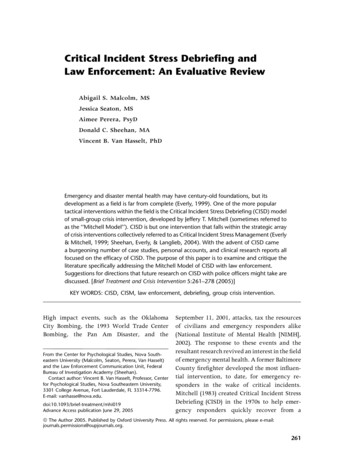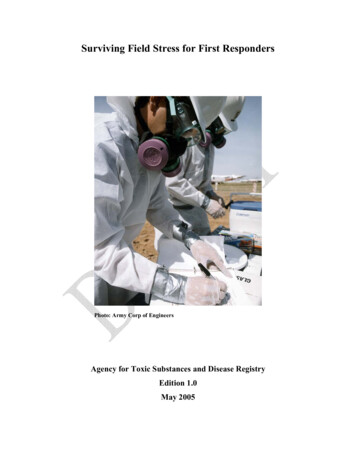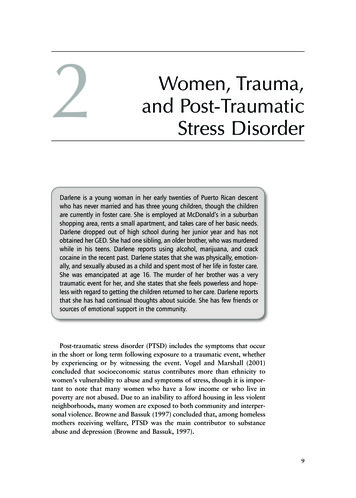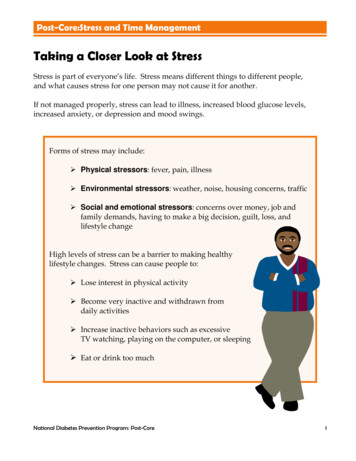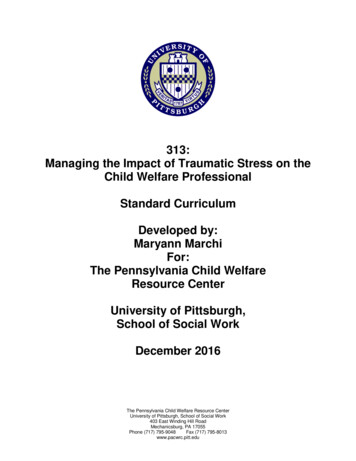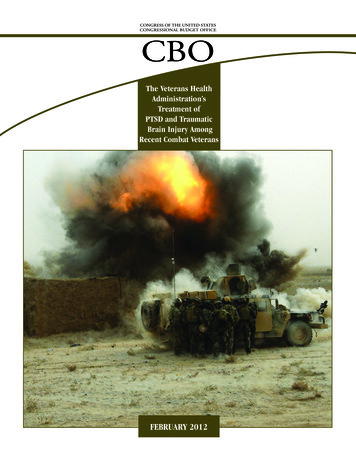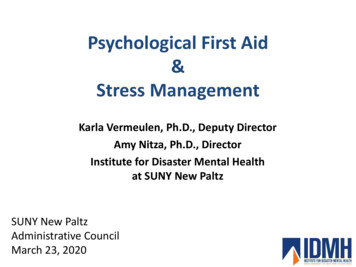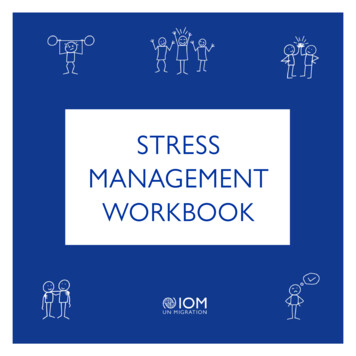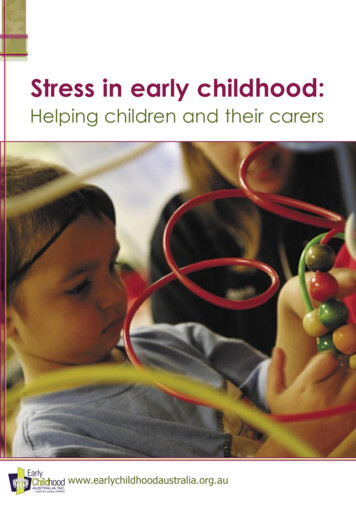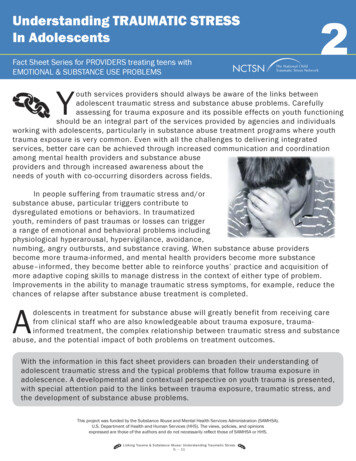
Transcription
Understanding TRAUMATIC STRESSIn AdolescentsFact Sheet Series for PROVIDERS treating teens withEMOTIONAL & SUBSTANCE USE PROBLEMSNCTSNThe National ChildTraumatic Stress Network2Youth services providers should always be aware of the links betweenadolescent traumatic stress and substance abuse problems. Carefullyassessing for trauma exposure and its possible effects on youth functioningshould be an integral part of the services provided by agencies and individualsworking with adolescents, particularly in substance abuse treatment programs where youthtrauma exposure is very common. Even with all the challenges to delivering integratedservices, better care can be achieved through increased communication and coordinationamong mental health providers and substance abuseproviders and through increased awareness about theneeds of youth with co-occurring disorders across fields.In people suffering from traumatic stress and/orsubstance abuse, particular triggers contribute todysregulated emotions or behaviors. In traumatizedyouth, reminders of past traumas or losses can triggera range of emotional and behavioral problems includingphysiological hyperarousal, hypervigilance, avoidance,numbing, angry outbursts, and substance craving. When substance abuse providersbecome more trauma-informed, and mental health providers become more substanceabuse–informed, they become better able to reinforce youths’ practice and acquisition ofmore adaptive coping skills to manage distress in the context of either type of problem.Improvements in the ability to manage traumatic stress symptoms, for example, reduce thechances of relapse after substance abuse treatment is completed.Adolescents in treatment for substance abuse will greatly benefit from receiving carefrom clinical staff who are also knowledgeable about trauma exposure, traumainformed treatment, the complex relationship between traumatic stress and substanceabuse, and the potential impact of both problems on treatment outcomes.With the information in this fact sheet providers can broaden their understanding ofadolescent traumatic stress and the typical problems that follow trauma exposure inadolescence. A developmental and contextual perspective on youth trauma is presented,with special attention paid to the links between trauma exposure, traumatic stress, andthe development of substance abuse problems.This project was funded by the Substance Abuse and Mental Health Services Administration (SAMHSA),U.S. Department of Health and Human Services (HHS). The views, policies, and opinionsexpressed are those of the authors and do not necessarily reflect those of SAMHSA or HHS.Linking Trauma & Substance Abuse: Understanding Traumatic StressII. – 11
*Maria’s StoryMaria, a 14-year-old girl, has been physically and sexuallyabused by her 22-year-old stepbrother for five years. Thefirst incident of abuse happened when she and her mothermoved in with the new stepfamily, after having been evicted fromtheir old apartment. In addition, Maria has seen her stepfatherseverely hit her mother several times, and is now constantly worriedabout her mother’s safety. Maria has become withdrawn at school andno longer participates in activities she once enjoyed. Once very popularwith her peers, she has isolated herself from many of her friends andspends most of her time alone. She fears that someone will find outabout the abuse and that she will be taken away from her mother. Theonly person that Maria has been spending a lot of time with is her cousinwho lives in the neighborhood. Lately, they have been skipping school andexperimenting with marijuana and alcohol. Maria used to be an honor rollstudent, but her grades have been spiraling downward. Her favorite teacher,Ms. Jacobs, is extremely concerned and has been trying to get Maria to talkto her about what is causing such a change.As you read through the pages that follow, think aboutcases like Maria’s, and consider the following questions: How common is child sexual abuse among adolescent girls? What are the mostcommon forms of trauma exposure among adolescents? How do these traumatic experiences affect adolescents in the long run? Are there characteristics that place some youth at greater risk for traumaexposure? Are there specific developmental effects of early trauma exposure? How is trauma exposure related to the development of substance abuseproblems?* “Maria’s story” was created by the authors as a composite representation of stories heard from real teenage clients struggling with these issues and provides examples of the challenges thatclinicians face in providing care for youth with trauma and substance abuse problems. Models portrayed are not representative of cases described.Linking Trauma & Substance Abuse: Understanding Traumatic StressII. – 12
Traumatic Exposure in AdolescentsTraumatic events are those that cause overwhelming anxiety or distress andinclude experiencing, witnessing, or being confronted with physical, verbal, andemotional abuse, or another event that involve actual or threatened death orserious injury to oneself or someone else.Responses to trauma exposure most often include intense fear, helplessness,or horror (American Psychological Association, 2000; National Child Traumatic StressNetwork, 2007). Trauma exposure is a common occurrence among adolescents. It isestimated that approximately 25% of children and adolescents will have experiencedat least one traumatic event by age 16 (Costello, Erkanli, Fairbank, & Angold, 2002).Estimates of trauma exposure among children and adolescents vary widely bycultural and social background. Consider the following facts: Inner-city children and adolescents are more likely to encounter community violence(Lipschitz, Rasmusson, Anywan, Cromwell, & Southwick, 2000). African-American, Pacific Islander, and American Indian/Alaska Native children andyouth have higher rates of substantiated child maltreatment compared to their white(Hispanic and non-Hispanic) peers (U.S. Department of Health and Human Services,Children’s Bureau, 2006). Refugee children and adolescents are more likely to have experienced war trauma anddisplacement (National Child Traumatic Stress Network, 2007). Homeless youth are particularly vulnerable to a wide range of traumatic exposureincluding sexual assault and being beaten or attacked with a weapon resulting in seriousinjury (Unger, Kipke, Simon, Montgomery, & Johnson, 1997). Maltreatment of children and adolescents with disabilities occurs 1.5 to 10 times moreoften than among children and adolescents without disabilities. Lesbian, gay, bisexual, and transgender (LGBT) youth experience increased rates ofphysical harassment, assault, and injury at school (Kosciw & Diaz, 2006; Goodenow,Szalacha, & Westheimer, 2006).Linking Trauma & Substance Abuse: Understanding Traumatic StressII. – 13
The Body’s Acute Response to TraumaIn the face of potentially dangerous or threatening situations, the body’s natural responseis to try to evaluate the level of danger and respond as quickly as possible. During timesof danger, the body’s alarm response (“fight, flight, or freeze”) is activated to help thebody’s organs react better to threat.Physical ResponseWhen fight, flight or freeze reactions are set in motion, the body prepares to respondto threat by sending more resources (e.g., blood and oxygen) to vital organs and conservingresources in others. See the boxes below for a list of some of the physical sensations thatoccur at this time: Heart pounding, palpitations, fastpulse Difficulty swallowing Nausea Sweating, clammy feeling Knot in stomach Cold hands Dry mouth and throat Pale face and skin Feeling detached from self orsurroundings Blurred vision, light seems brighter Feeling frozen or immobile Feeling spaced out or in anotherworldMental ResponseWhen exposed to dangerous or threatening situations, the mental mechanisms thathelp us make everyday decisions temporarily shut down. This response enables us to makemore primitive responses and take quick action rather than to think carefully about the situation at hand.Long-lasting ProblemsWhile these responses are important and vital for survival, prolonged exposure tothreatening situations, or exposure to threat in situations where a protective response is inhibited (such as sexual abuse), can result in lasting physical and emotional problems.Linking Trauma & Substance Abuse: Understanding Traumatic StressII. – 14
When trauma leads to emotionaland behavioral problems Individuals who experience trauma early in their lives usually develop anumber of difficulties (Briere & Spinazzolla, 2005; APA, 2000; NationalChild Traumatic Stress Network, 2007; Strand, Sarmiento, & Pasquale,2005) including:Post Traumatic Stress Disorder:PTSD is characterized by symptoms that are clustered into three broad categories:1. Reexperiencing the traumatic event throughintrusive thoughts or dreams of the event, or intensepsychological distress when exposed to reminders ofthe event;2. Persistent avoidance of thoughts, feelings, images,or locations that remind the adolescent of or areassociated with the traumatic event;3. Increased arousal such as hypervigilance, irritability,exaggerated startle response, and sleeping difficulties(American Psychological Association, 2000).How Common Is PTSD? An epidemiologic study (Kilpatrick,Ruggiero, Acierno, Saunders, Resnick, &Best, 2003) of adolescents using a nationalsample found that 3.7% of males and 6.3%of females met diagnostic criteria forPTSD. Another epidemiologic study of olderadolescents and young adults (aged 16–22)found prevalence rates for PTSD to be 1%in males and 3% in females (Cuffe, Addy,Garrison, Waller, Jackson, McKeown, et al.,1998).Although exposure totraumatic events doesnot always lead to PTSD,traumatized individualsoften experience some PTSDsymptoms. They may reportongoing fear of the eventoccurring again, persistentflashbacks and nightmares,avoidance of things thatremind them of the event,being on edge all the time, orhaving trouble sleeping. PTSD appears to be a fairly commondiagnosis among adolescents seekingtreatment. A study of adolescents treatedin a psychiatric inpatient unit found that42% of the overall sample (47.4% of females,34.2% of males) met diagnostic criteriafor PTSD (Koltek, Wilkes, & Atkinson,1998). One study examined female juvenileoffenders and a control sample matched onage and socioeconomic status (SES). Ratesof PTSD were significantly different betweenthe two groups, with 37% of offenders and4% of controls meeting diagnostic criteriafor PTSD (Dixon, Howie, & Starling, 2004).Linking Trauma & Substance Abuse: Understanding Traumatic StressII. – 15
Avoidance Activities:The intense flood of negative emotions that often accompany traumatic stress can leadindividuals to rely on (or overrely on) potentially problematic ways of avoiding trauma-relateddistress. Some examples of such avoidance activities include: Dissociation: Among the common types of dissociation that traumatized individuals may experience are depersonalization, derealization (feelings of unreality),fugue states, and dissociative identity disorder. Substance abuse: Individuals with complex and chronic trauma histories are morelikely to use drugs and alcohol. Research studies suggest that among individualswith PTSD and substance use disorders, drug cravings increase with exposure totrauma reminders, suggesting that substance abuse for these individuals is anautomatic avoidant response to prevent the onset of distressing emotions (Coffey,Saladin, Drobes, Brady, Dansky, & Kilpatrick, 2002; Saladin, Drobes, Coffey,Dansky, Brady, & Kilpatrick, 2003). Tension reduction activities: Compulsive sexual behavior, bingeing and purging,self-mutilation, and suicidality are also common among individuals exposed toearly trauma.Anxiety and Mood Problems:Exposure to trauma can result in symptoms or disorders involving anxiety and depression.Anxious youth can appear very worried, nervous, or fearful, and may refuse to participate indaily activities such as school or social events. Depressed youth can display deep sadness,constant crying, trouble concentrating, irritability, feelings of guilt, and thoughts of wantingto die. Dysregulated emotional states can also be characterized by intense anger, leadingyouth to display aggressive or disruptive behavior.Negative perceptions about oneself and the world:Individuals who have experienced trauma and adverse life events often suffer from low selfesteem, self-blame, helplessness, hopelessness, expectations of rejection and loss, anoverestimation of the amount of danger in the world, and/or expectations of maltreatment orabandonment by others.Somatoform Symptoms:This refers to bodily distress or dysfunction that arises from (or is significantly intensified by)psychological phenomena. Traumatized youth may report ongoing physical complaints andhave difficulty meeting academic or social responsibilities.Interpersonal Difficulties:Youth who have been hurt by loved ones often develop a loss of trust or withdrawal andisolation from others, which can lead to ongoing conflict and social problems.Linking Trauma & Substance Abuse: Understanding Traumatic StressII. – 16
Youth Responses toDifferent Traumatic EventsTraumatic stress reactions for children and adolescents can alsovary by type of trauma. Below are some highlights from the relevantresearch on this area.Physical, Sexual, and Emotional abuseIt is often hard to imagine the extent of theAn association has been foundimpact on children and adolescents of experiencingbetween childhood sexual abusephysical, sexual, or emotional abuse by a loved orand earlier onset of alcoholdisorders, the co-occurrence oftrusted one. Research studies in this area havemorepsychiatricconditions as adults, anddemonstrated a range of resulting problems includingmore social problems (Zlotnick, Johnson,psychological distress, behavioral difficulties, andStout, Zywiak, Johnson, & Schneider,social problems (Porter, Lawson, & Bigler, 2005).2006). The same study found that childhoodphysical abuse was related to greaterSpecifically, physically abused and neglected childrenproblems in adulthood, socialdemonstrate increased risk for difficulties in language drinkingand psychiatric dysfunction, and the codevelopment and school readiness. Children withoccurrence of more psychiatric conditions.histories of physical abuse show deficits in verbal andmemory skills. Research on girls indicates that those who have been sexually abused displaylower cognitive abilities and academic achievement (Spaccarelli & Fuchs, 1997).Interpersonal Violence and VictimizationInterpersonal violence such as physical or sexual assault or witnessed violence hasbeen shown to increase the risk of PTSD, depression, and substance abuse or dependenceamong adolescents, even after controlling for demographic factors and family substance useproblems (Kilpatrick, et al., 2003). Many characteristics of interpersonal abuse can havean impact on how children who experience abuse respond. For example, the identity of theperpetrator, the type of abuse, its frequency, and whether force was used can all have aspecific impact on an individual’s response to the trauma.Exposure to Community ViolenceExposure to community violence can have a serious psychosocial impact in childrenand adolescents. For example, a study of youth aged 12–17 found that exposure tocommunity violence was often associated with conduct disorder and externalizing problemstwo years later (McCabe, Lucchini, Hough, Yeh, & Hazen, 2005). In another study, AfricanAmerican adolescents aged 10–18 exposed to community violence reported more depressivesymptoms, after controlling for gender and age (Fitzpatrick, Piko, Wright, & LaGory, 2005).Interestingly, in this same study, social capital (personal and social resources) was shown tobe inversely related to adolescent depression.Linking Trauma & Substance Abuse: Understanding Traumatic StressII. – 17
Natural Disaster/TerrorismThe impact of trauma due to natural disasters or terrorism can also be great foradolescents. Traumatic grief reactions to tragic losses suffered as a result of the attackon the World Trade Center on September 11, 2001,included symptoms of PTSD, anxiety,depression, poor coping responses, and secondary adversities resulting from the event(Brown & Goodman, 2005). In a study of Nicaraguan youth who had experienced HurricaneMitch (Goenjian, Molina, Steinberg, Fairbanks, Alvarez, Goenjian, & Pynoos, 2001),researchers found that posttraumatic stress symptom severity was associated with the levelof impact and devastation and the presence of thoughts of revenge. Depressive symptomswere associated with severity of the posttraumatic stress reactions, the death of a familymember, and being female.Traumatic Loss and GriefAlthough all adolescents grieve after the death of a loved one, traumatic grief occurswhen the teen experiences the death/loss as a traumatic event and experiences many of thesymptoms of PTSD (e.g., intrusive thoughts about the death, increased physical agitation,emotional numbing). These PTSD-like symptoms hinder the natural bereavement process, cancause interference in daily functioning, and do not allow the teen to process and, eventually,let go of the loss (Goodman, Cohen, Epstein, Kliethermes, Layne, Macy, & Ward-Wimmer,2004). Traumatic grief is often complicated by the secondary consequences of the loss suchas moving in with grandparents after the loss of a parent (Cohen & Mannarino, 2004).Medical TraumaA study by Costello, Erkanli, Fairbank, & Angold (2002) found that medical trauma(either serious illness or serious accident) was the third-most common traumatic event foryouth to experience. Medical trauma can include severe injury, diagnosis and treatment ofa life-threatening illness, or other serious medical procedure. Medical trauma can have asignificant impact on the emotional well-being of youth as well as of their parents. A studyby Winston, Kassan-Adams, & Garcia-Espana (2003) found that 17% of youth who sufferedsevere injuries and 15% of their parents reported meeting symptom criteria for PTSD; 22% ofyouth and 33% of parents reported meeting symptom criteria for Acute Stress Disorder (ASD).Complex TraumaThe term complex trauma is often applied when a child experiences multiple, chronictraumatic events beginning in early childhood (e.g., neglect, maltreatment, witness to domestic violence). Complex trauma can lead to a variety of psychosocial problems including(but not limited to) PTSD, difficulties with attachment, anxiety, substance abuse, aggressivebehaviors, eating disorders, and diverse physical disorders such as problems with the metabolic, cardiovascular, and immunological systems (National Child Traumatic Stress Network,2007). In addition, because of the problems that can develop after living with chronic trauma (e.g., lack of attachment, emotional dysregulation, inability to distinguish danger cues),these youth are at greater risk to be revictimized and experience subsequent trauma (Spinazzola, Ford, Zucker, van der Kolk, SilvaSmith, & Blaustein, 2005).Linking Trauma & Substance Abuse: Understanding Traumatic StressII. – 18
Risk and Protective FactorsAssociated with Trauma ExposureSeveral factors have been identified as placing youth at risk forexperiencing trauma including:Family characteristics: Trauma exposure is more common among youth whose families arecharacterized by relationship problems and parental psychopathology (Costello et al, 2002).This same study found that a family history of mental illness doubles the risk of traumaexposure. A closer look at gender differences revealed that girls were at greater risk if eitherparent had a criminal record or if the home was poor or disorganized.Stressful events: Experiencing stressful events—such as parental separation or divorce,moving or changing schools, or breaking up with a friend—has been associated withincreased risk for trauma exposure (Costello et al., 2002). Adolescents who haveexperienced high levels of stress in the context of exposure to violence are at greater risk forpoor psychological outcomes (Self-Brown, LeBlanc, & Kelley, 2004).Homelessness: Homeless youth are at a greater risk for experiencing trauma when comparedto other adolescents. Often times, these teens have been the victims of severe andrecurrent physical, emotional, and/or sexual abuse. When the abuse is at the hand of theircaregivers, the result is often running away or being forced to leave their homes. Femalehomeless adolescents are particularly at risk for experiencing sexual trauma compared totheir male counterparts. Even after leaving an abusive home, these teens are extremelyvulnerable to continued maltreatment once on their own or residing in shelters (Gwadz, Nish,Leonard & Strauss, 2004).Monitoring: Research has shown that spending more time in risky contexts (e.g.,unmonitored time with friends) and less time in protective contexts (e.g., structured timein recreational activities or with family) were associated with more exposure to violence(Richards, Larson, Miller, Luo, Sims, Parrella, & McCauley, 2004). This exposure, in turn, canlead to development of delinquent behaviors or emotional distress.Sibling influences: Exposure to deviant activities by an older sibling and participation insuch deviant activities with a sibling were found to increase the risk for development ofmany problems including arrests, drug use, antisocial behavior, deviant peer association,and early sexual experience, as well as the experience of traumatic stress (Snyder, Bank,& Burraston, 2005). These problems were particularly salient in the context of early siblingconflict and ineffective parenting. According to this study, modeling of antisocial behaviorand coparticipation in drug use and other risky activities increased chances of victimizationin risky contexts.Having more than one of the of the problems mentioned above places youth atan even greater risk of experiencing additional difficulties. For example, onestudy examined the cumulative effect of risk, and found that the experience ofsexual abuse was more common among children who had a higher number of“vulnerability factors” (Costello et al., 2002).Linking Trauma & Substance Abuse: Understanding Traumatic StressII. – 19
Trauma Exposure andYouth DevelopmentSeveral studies in the area of child maltreatment have been conducted toidentify ways in which this type of trauma exposure is associated withproblems in childhood development. Findings point to possible alterationsin specific biological stress systems, which, in turn, can lead to adverse ef fectson brain development as well as delays in language, cognitive, and academicskills (De Bellis, 2005).It is impor tant to note that not all children who are maltreated areadversely af fected. Additionally, although environmental stress plays a largerole in this process, some evidence suggests that the negative ef fects of stresson the central ner vous system may be reversible.Child maltreatment can have an impact on the body’s physical responseto ongoing stress. Because neurobiological stress systems are interconnectedat many levels, dysregulation in one system can lead to problems in others. Forinstance, dysregulation of the neurobiological stress system is thought to leadto several of the symptoms associated with PTSD.Critical stress response mechanisms that have been shown to be affected bychildhood maltreatment include: Dysregulation of the serotonin system (Kaufman, Birmaher, Perel, Dahl, Stull, Brent, etal., 1998), which increases the risk for depression, suicidality, and aggression; Increased sensitivity to the limbic-hypothalamic-pituitary-adrenal (LHPA) axis, whichis associated with psychiatric symptoms (e.g., depression, anxiety, sleep difficulties) andphysical problems (e.g., memory loss, difficulty concentrating); Decreased ability of the immune system to respond due to the dysregulation of theLHPA axis, which can increase the risk for developing infectious diseases.In addition, neuroimaging findings have suggested a link between childmaltreatment and specific problems in brain development and maturation(De Bellis, Keshavan, Clark, Casey, Giedd, Boring, et al., 1999; De Bellis &Keshavan, 2003). Prolonged exposure to such stressors is thought to impairneurophyschological functioning and have a direct impact on memor y, learning,and the ability to store and process spatial information due to its impact on thehippocampus.Linking Trauma & Substance Abuse: Understanding Traumatic StressII. – 20
Trauma as a Risk Factorfor Substance UseExposure to traumatic events and the experience of grief andloss can place youth at higher risk of developing substance useproblems.Many providers are familiar with the self-medication hypothesis: that people developsubstance abuse problems in an attempt to manage distress associated with the effects oftrauma exposure and traumatic stress symptoms. This theory suggests that youth turn toalcohol and other drugs to manage the intense flood of emotions and traumatic remindersassociated with PTSD, or to numb themselves from the experience of any intense emotion,whether positive or negative.Research findings have shown that, in a substantial proportion of youth, substanceuse problems develop following exposure to trauma (25–76%) or the onset of PTSD (14–59%) (Clark, Lesnick, & Hegedus, 1997; Deykin & Buka, 1997; Giaconia, Reinherz, Hauf,Paradis, Wasserman, & Langhammer, 2000; Perkonigg, Kessler, Storz, & Wittchen, 2000).Specifically, the experience of physical assault, sexual assault, and witnessing violence hasbeen associated with a greater risk for substance abuse or dependence (Kilpatrick, Acierno,Saunders, Resnick, & Best, 2000). In addition, having PTSD or traumatic stress symptomscan place youth at greater risk of developing substance abuse or dependence (Kilpatrick, etal., 2000; Kilpatrick, et al., 2003; Stevens, Murphy, & McKnight, 2003).ARecent substance abuse treatment outcome studies with adults have documentedthat elevated PTSD and traumatic stress symptoms at follow-up are associated with relapseafter substance abuse treatment (Read, Brown, & Kahler, 2004). Higher initial symptomseverity among youth with co-occurring traumatic stress and substance abuse problems wasassociated with more internal distress and violent behavior at posttreatment (Titus, Dennis,White, Scott, & Funk, 2003).l i ke l y ex p l a n a t i o n fo r t h e l i n k b e t we e n t r a u m a t i c s t r e s s a n d s u b s t a n c ea b u s e i s o f fe r e d by s t u d i e s t h a t ex a m i n e l eve l s o f c r av i n g fo r s u b s t a n c e s .Re s e a rc h w i t h a d u l t s i n t h i s a r e a s u g g e s t s t h a t s u b s t a n c e u s e c r av i n gincreases among individuals with co-occurring trauma and substance abusew h e n t h ey a r e ex p o s e d to c u e s r e l a te d to t h e t r a u m a t i c eve n t ( C o f fey, e t a l . ,2 0 0 2 ; S a l a d i n , e t a l . , 2 0 0 3 ) . T h i s s u g g e s t s t h a t fo r i n d i v i d u a l s w i t h b o t ht y p e s o f p ro b l e m s , t r a u m a a n d l o s s r e m i n d e r s c a n s e r ve a s t r i g g e r s fo r f u t u r es u b s t a n c e u s e . Fu r t h e r ev i d e n c e i s p rov i d e d by f i n d i n g s i n d i c a t i n g t h a t a m o n ga d u l t s w i t h c o c a i n e d e p e n d e n c e , i n d i v i d u a l s w i t h P T S D we r e m o r e l i ke l y tou s e fo l l ow i n g n e g a t i ve ex p e r i e n c e s ( s u c h a s u n p l e a s a n t e m o t i o n s a n d p hy s i c a ld i s c o m fo r t ) w h e n c o m p a r e d to t h o s e w i t h o u t P T S D ( Wa l d ro p , B a c k , Ve rd u i n , &B r a d y, 2 0 0 6 ) . I n t h e a b s e n c e o f c o p i n g s t r a te g i e s to m a n a g e d i s t r e s s a s s o c i a te dw i t h t r a u m a , i n d i v i d u a l s w i t h s u b s t a n c e a b u s e p ro b l e m s m ay b e m o r e l i ke l y touse.Linking Trauma & Substance Abuse: Understanding Traumatic StressII. – 21
PTSD. Another epidemiologic study of older adolescents and young adults (aged 16-22) found prevalence rates for PTSD to be 1% in males and 3% in females (Cuffe, Addy, Garrison, Waller, Jackson, McKeown, et al., 1998). Although exposure to . traumatic events does not always lead to PTSD, traumatized individuals often experience some PTSD symptoms.
